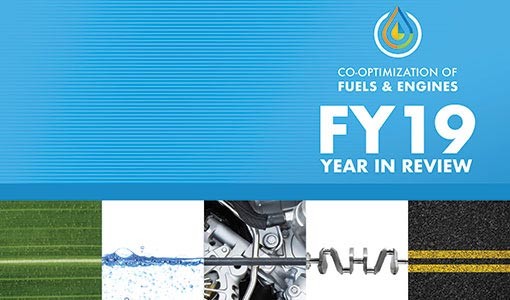Fuel and Engine Research Brings Cleaner, More Efficient Cars and Trucks Closer to Finish Line

Typically, passenger cars and light-duty (LD) trucks account for 55% of U.S. transportation energy use. While the coronavirus pandemic has temporarily curtailed the amount of time most Americans spend behind the wheel, sharp increases in demand for deliveries have pressed some commercial trucks—which usually account for more than 25% of transportation-related fuel consumption—into overtime.
Researchers from the National Renewable Energy Laboratory (NREL) and eight other national laboratories are collaborating on the U.S. Department of Energy's Co-Optimization of Fuels & Engines (Co-Optima) initiative to improve efficiency while reducing emissions and costs of the entire on-road fleet, from passenger cars to big rigs. A report released this week highlights the most significant Co-Optima research and development (R&D) successes of Fiscal Year 2019 (FY19), describing how the team has built on earlier accomplishments related to simultaneous improvements of fuels and engines for LD vehicles and is now turning more attention to medium-duty (MD) and heavy-duty (HD) vehicles.
"Yes, we've included trucks in the research mix since the beginning, and this is certainly not the end of our work on fuels and engines for light-duty vehicles," said NREL Senior Research Fellow, Advanced Fuels and Combustion Platform Leader, and Co-Optima Leadership Team Member Robert McCormick. "Now, we're exploring how fuels work with more innovative engine designs in passenger cars, and taking a closer look at challenges that are unique to commercial trucks."
After completing a major body of research focused on turbocharged spark-ignition (SI) engines in FY18, Co-Optima’s FY19 LD R&D shifted focus to multimode solutions that employ multiple engine operating modes to maximize engine efficiency and fuel economy. The team is starting to investigate how multimode strategies can be applied to MD and HD engines, as well as how new approaches such as ducted fuel injection can reduce diesel truck emissions and how biomass-based fuels can be most effectively used in these engines.
NREL researchers' contributions to Co-Optima accomplishments in the last year include:
- Pinpointing the fuel properties most critical to reducing emissions from mixing-controlled compression ignition diesel engines
- Assessing Co-Optima fuel blendstocks’ potential production costs, environmental impact, and value to refiners
- Identifying a biofuel for MD and HD engines that can be made with renewable corn stover and shows potential for competitive production costs, high performance, low emissions, and infrastructure compatibility
- Establishing methods to accurately predict how heat of vaporization impacts emissions and performance of SI engines with oxygenate-based fuels
- Exploring fuel properties needed to deliver desired engine performance and efficiency, along with lower emissions and costs, for multimode and other combustion regimes
- Developing tools for rapid and precise screening of candidate biofuels.
"Internal combustion vehicles are going to be around for a long time, especially in the heavy-duty sector," McCormick said. "Why don’t we do everything we can to make them as clean, efficient, and affordable as possible?"
The first-of-its-kind Co-Optima effort is designed to provide American industry with the scientific underpinnings needed to maximize vehicle performance and efficiency, leverage domestic fuel resources, and reduce life cycle emissions. Sponsored by the U.S. Department of Energy’s Office of Energy Efficiency and Renewable Energy’s Vehicle Technologies Office and Bioenergy Technologies Office, Co-Optima partners include NREL as well as Argonne, Idaho, Lawrence Berkeley, Lawrence Livermore, Los Alamos, Oak Ridge, Pacific Northwest, and Sandia National Laboratories, plus more than 20 university and industry partners.
Another recent report summarized earlier findings from previous years of the Co-Optima initiative, which focused primarily on turbocharged SI engines for LD vehicles.
Read the full FY19 Year in Review report. Also, learn more about U.S. Department of Energy Co-Optima activities and NREL's transportation and mobility research.
Last Updated May 28, 2025
